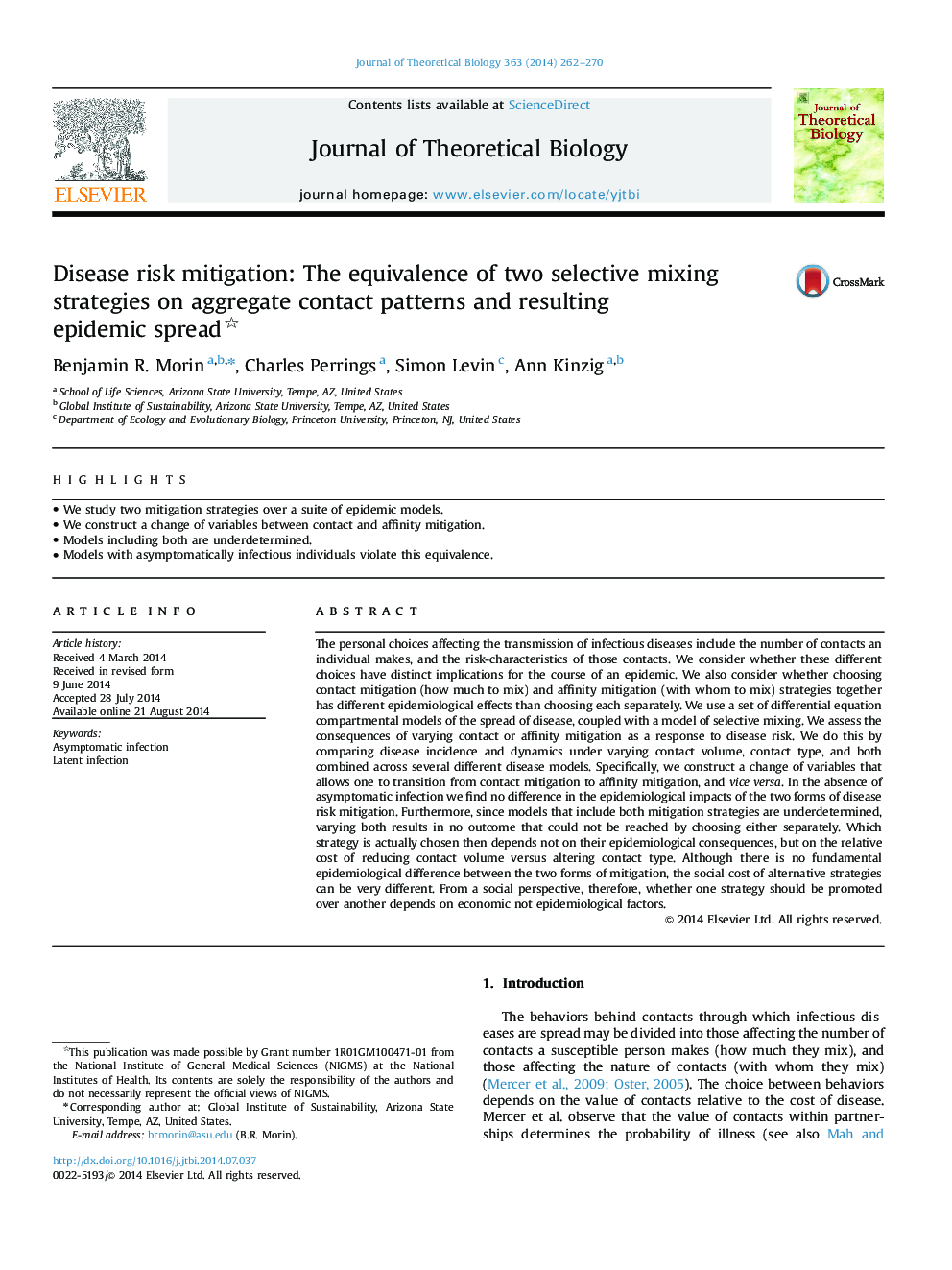| کد مقاله | کد نشریه | سال انتشار | مقاله انگلیسی | نسخه تمام متن |
|---|---|---|---|---|
| 6370223 | 1623847 | 2014 | 9 صفحه PDF | دانلود رایگان |
عنوان انگلیسی مقاله ISI
Disease risk mitigation: The equivalence of two selective mixing strategies on aggregate contact patterns and resulting epidemic spread
ترجمه فارسی عنوان
کاهش خطر بیماری: هم ارزیابی دو راهبرد مخلوط انتخابی بر الگوهای تماس کلی و گسترش اپیدمی ناشی از آن
دانلود مقاله + سفارش ترجمه
دانلود مقاله ISI انگلیسی
رایگان برای ایرانیان
کلمات کلیدی
عفونت بدون علامت، عفونت های خاموش
ترجمه چکیده
انتخاب شخصی که بر انتقال بیماری های عفونی موثر است شامل تعداد مخاطبین فردی است و ویژگی های خطر این مخاطبین. ما در نظر می گیریم که آیا این گزینه های مختلف دارای پیامدهای متمایزی برای دوره اپیدمی هستند. ما همچنین در نظر داریم که آیا انتخاب روش کاهش تماس (چقدر مخلوط) و کاهش استحکامات (که با آنها ترکیب می شود) است، با هم اثرات اپیدمیولوژیکی متفاوت نسبت به انتخاب هر یک از جداول دارند. ما از مجموعه ای از معادلات دیفرانسیل مجزا از گسترش بیماری استفاده می کنیم، همراه با یک مدل مخلوط انتخابی. ما نتایج عواقب مختلف کاهش یا کاهش میل جنسی را به عنوان پاسخ به خطر بیماری بررسی می کنیم. ما این کار را با مقایسه میزان بروز و پویایی بیماری در حجم تماس مختلف، نوع تماس و هر دو در چند مدل بیماری مختلف ترکیب می کنیم. به طور خاص، ما یک تغییر متغیرها را ایجاد می کنیم که اجازه می دهد تا از تغییرات مخاطب تا کاهش تداخل، و برعکس. در غیاب عفونت بدون علامت، هیچ تاثیری در اثرات اپیدمیولوژیک دو نوع کاهش خطر بیماری وجود ندارد. علاوه بر این، از آنجایی که مدل هایی که شامل هر دو استراتژی کاهش است، کم تعریف می شوند، اما هر دو در نتیجه نتایجی به دست نمی دهند که با انتخاب به صورت جداگانه نمی تواند نتیجه گیری شود. کدام استراتژی در واقع انتخاب شده است و بستگی به پیامدهای اپیدمیولوژیک آن ندارد، اما هزینه نسبی کاهش حجم تماس با تغییر نوع تماس است. اگر چه تفاوت های اساسی اپیدمیولوژیک بین دو نوع کاهش است، هزینه های اجتماعی راهبرد های جایگزین می تواند بسیار متفاوت باشد. بنابراین از یک دیدگاه اجتماعی، آیا یک استراتژی باید بر دیگری ارتقا یابد، بستگی به عوامل اقتصادی اپیدمیولوژیک دارد.
موضوعات مرتبط
علوم زیستی و بیوفناوری
علوم کشاورزی و بیولوژیک
علوم کشاورزی و بیولوژیک (عمومی)
چکیده انگلیسی
The personal choices affecting the transmission of infectious diseases include the number of contacts an individual makes, and the risk-characteristics of those contacts. We consider whether these different choices have distinct implications for the course of an epidemic. We also consider whether choosing contact mitigation (how much to mix) and affinity mitigation (with whom to mix) strategies together has different epidemiological effects than choosing each separately. We use a set of differential equation compartmental models of the spread of disease, coupled with a model of selective mixing. We assess the consequences of varying contact or affinity mitigation as a response to disease risk. We do this by comparing disease incidence and dynamics under varying contact volume, contact type, and both combined across several different disease models. Specifically, we construct a change of variables that allows one to transition from contact mitigation to affinity mitigation, and vice versa. In the absence of asymptomatic infection we find no difference in the epidemiological impacts of the two forms of disease risk mitigation. Furthermore, since models that include both mitigation strategies are underdetermined, varying both results in no outcome that could not be reached by choosing either separately. Which strategy is actually chosen then depends not on their epidemiological consequences, but on the relative cost of reducing contact volume versus altering contact type. Although there is no fundamental epidemiological difference between the two forms of mitigation, the social cost of alternative strategies can be very different. From a social perspective, therefore, whether one strategy should be promoted over another depends on economic not epidemiological factors.
ناشر
Database: Elsevier - ScienceDirect (ساینس دایرکت)
Journal: Journal of Theoretical Biology - Volume 363, 21 December 2014, Pages 262-270
Journal: Journal of Theoretical Biology - Volume 363, 21 December 2014, Pages 262-270
نویسندگان
Benjamin R. Morin, Charles Perrings, Simon Levin, Ann Kinzig,
